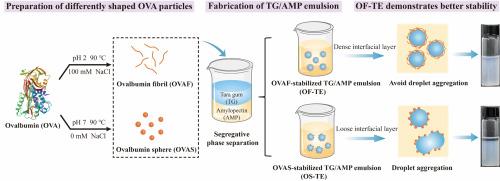Novel food-grade water-in-water emulsion fabricated by amylopectin and tara gum: Property evaluation and stability analysis
IF 10.7
1区 化学
Q1 CHEMISTRY, APPLIED
引用次数: 0
Abstract
To surmount the limitation of the instability of the currently reported water-in-water (W/W) emulsions, novel W/W emulsionss were constructed using amylopectin (AMP) and tara gum (TG) as the phases, and differently shaped ovalbumin (OVA) particles were used as stabilizers to improve the stability of W/W emulsions. Experiments displayed that the conformation of OVA could be changed by heating treatment, thus forming fibrous or spherical OVA particles that had the potential to stabilize TG-in-AMP (TG/AMP) emulsions. The emulsions had the best stability when the pH was 4 and the concentration of OVA particles was 3 %. Moreover, since ovalbumin fibril (OVAF) had better adsorption at the water-water interface than ovalbumin sphere (OVAS), OVAF-stabilized TG/AMP emulsion (OF-TE) had a relatively denser interfacial layer and exhibited more satisfactory ionic stability and physical stability than OVAS-stabilized TG/AMP emulsion (OS-TE). The rheological results demonstrated that OVAF and OVAS had little effect on the viscosity of TG/AMP emulsions. In brief, OVAF was more effective in improving the stability of TG/AMP emulsions than OVAS, and OF-TE did not show phase separation for at least 5 days. This study may be of great significance in improving the stability of food-grade W/W emulsions.

由直链淀粉和塔拉胶制成的新型食品级水包水乳液:性能评估和稳定性分析
为了克服目前报道的水包水(W/W)乳剂不稳定的局限性,研究人员以直链淀粉(AMP)和塔拉胶(TG)为相,构建了新型的水包水乳剂,并使用不同形状的卵清蛋白(OVA)颗粒作为稳定剂,以提高水包水乳剂的稳定性。实验表明,加热处理可改变卵清蛋白的构象,从而形成纤维状或球状卵清蛋白颗粒,这些颗粒具有稳定 TG-in-AMP (TG/AMP) 乳剂的潜力。当 pH 值为 4、OVA 颗粒浓度为 3% 时,乳剂的稳定性最好。此外,由于卵清蛋白纤维(OVAF)比卵清蛋白球(OVAS)在水-水界面上有更好的吸附性,因此 OVAF 稳定的 TG/AMP 乳剂(OF-TE)比 OVAS 稳定的 TG/AMP 乳剂(OS-TE)有相对更致密的界面层,并表现出更令人满意的离子稳定性和物理稳定性。流变学结果表明,OVAF 和 OVAS 对 TG/AMP 乳液的粘度影响不大。简而言之,OVAF 在提高 TG/AMP 乳剂的稳定性方面比 OVAS 更有效,OF-TE 至少在 5 天内没有出现相分离现象。这项研究对于提高食品级水包油型乳液的稳定性具有重要意义。
本文章由计算机程序翻译,如有差异,请以英文原文为准。
求助全文
约1分钟内获得全文
求助全文
来源期刊

Carbohydrate Polymers
化学-高分子科学
CiteScore
22.40
自引率
8.00%
发文量
1286
审稿时长
47 days
期刊介绍:
Carbohydrate Polymers stands as a prominent journal in the glycoscience field, dedicated to exploring and harnessing the potential of polysaccharides with applications spanning bioenergy, bioplastics, biomaterials, biorefining, chemistry, drug delivery, food, health, nanotechnology, packaging, paper, pharmaceuticals, medicine, oil recovery, textiles, tissue engineering, wood, and various aspects of glycoscience.
The journal emphasizes the central role of well-characterized carbohydrate polymers, highlighting their significance as the primary focus rather than a peripheral topic. Each paper must prominently feature at least one named carbohydrate polymer, evident in both citation and title, with a commitment to innovative research that advances scientific knowledge.
 求助内容:
求助内容: 应助结果提醒方式:
应助结果提醒方式:


